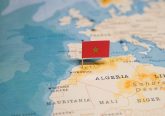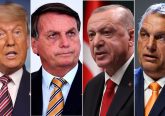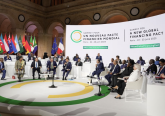Introduction
After World War II, the multilateral system was designed to promote international peace, drive economic growth, and ensure global cooperation. Institutions such as the United Nations, International Monetary Fund, and World Trade Organisation established alliances, treaties, and agreements with the aim of achieving shared prosperity. In recent years, however, cracks are beginning to appear within this system. The world has witnessed a sharp increase in geopolitical crises like the Russia – Ukraine war, withdrawals from treaties, trade protectionism and back-sliding democracies. The multilateral system has also failed to deliver comprehensive solutions to global issues such as COVID-19 and climate change.
As the inequalities within the multilateral system become increasingly apparent, calls for change are starting to reverberate across the Global South. Countries in the Global South, particularly those in Africa, face the most significant climate crisis risks despite contributing the least to global emissions. One avenue through which the Global South is attempting to transform the current system is through the BRICS forum. BRICS – Brazil, Russia, India, China, and South Africa – was coined by Goldman Sachs economist Jim O’Neill after he posited that these four economies would dominate the global economy by 2050. To date, BRICS has operated as a forum for economic cooperation in the Global South despite not being a formal multilateral organisation like the United Nations or the World Bank.
For countries in the Global South, the BRICS group represents an alternative route to unlocking development finance and increasing trade and investment. In August 2023, Iran, Saudi Arabia, Egypt, Argentina, the UAE and Ethiopia were admitted to the forum. Other countries, including Algeria, Indonesia, Ethiopia, Cuba, the Democratic Republic of Congo, and Gabon, have expressed interest in joining the forum.
What does the shift from BRICS to BRICS+ mean for the group, the current multilateral system, and the future of the Global South?
BRICS+
Despite presenting a united front during the BRICS summits, the group bears significant differences and disparities. Ideologically, the BRICS group comprises countries with vastly different values, geographies, and cultures. Moreover, there is considerable variation in the countries’ global economic and geopolitical status. China has the group’s largest GDP, valued at 16.86 trillion U.S. dollars in 2021, while the others rank below three trillion. South Africa has consistently had the smallest economy of the BRICS bloc. Following Russia’s invasion of Ukraine, Russia’s membership in the group has caused significant tension. Relations between India and China have also worsened as the border dispute in the Himalayan region escalates.
Plans to increase membership have caused further disagreement within the group. China’s President Xi Jinping was the leading proponent of the admission of new members, arguing that an enlarged BRICS gives the Global South a more significant voice in world affairs. For Brazil and India – countries with stronger alliances with the West – there was more trepidation about who would be admitted to the forum and how this would affect the group’s power dynamics.
Admitting more countries into the group introduces greater economic diversity and differing – and sometimes conflicting – agendas. While Argentina is in a dire economic state, Iran continues to face Western-led sanctions, and Saudi Arabia was the fastest-growing G20 economy in 2022. The group’s ability to remain a credible force for reshaping global governance will depend on its capacity to forge consensus among its diverse members.
The Current Multilateral System
The BRICS leadership has consistently pushed for strengthening cooperation to promote peace, a more representative international order, a reinvigorated and reformed multilateral system, sustainable development, and inclusive growth. Whether this declaration will translate into concrete action will determine the group’s future. The extent to which BRICS+ can influence the multilateral system to achieve its goals will depend on unity within the group and willingness to work with outside partners. Given that each member retains their sovereignty and is free to develop alliances with Western and other powers, the group must agree on its principles before negotiating as a bloc so that no group member diverts from the agenda.
There has been talk of a BRICS currency that could supplant the dollar, alongside other potential avenues to move away from Western domination toward a more inclusive multilateral system. However, the ability to convert discussion to action has been limited. As of September 2023, the BRICS+ has not elaborated on a global governance model. The forum has set up the New Development Bank (NDB) to mobilise resources for infrastructure and sustainable development projects in emerging markets and developing countries (EMDCs). As more members join the forum, the success of BRICS institutions will depend on the ability to fund and support the goals of existing and new members.
The Global South
As more countries have expressed interest in joining the BRICS, traditionally Western-centric organisations are making a concerted effort to draw in the Global South. During the G20 September 2023 meeting, the African Union (AU) was newly admitted as a permanent member. India’s Prime Minister Narendra Modi asserted that the AU’s membership represents an opportunity to give the continent a voice. The Group of Seven (G7) has also taken steps to strengthen its outreach to the Global South. At the 2023 Hiroshima Summit, the G7 proposed new infrastructure and development initiatives to improve their relations with the Global South. As these new avenues for receiving investments and bilateral agreements are introduced, countries in the Global South are finding alternative options for development and geopolitical alignment.
However, the G7’s engagement with the Global South differs significantly from the approach of the BRICS. While the G7 occasionally invites Global South countries for partial dialogues, BRICS have explicitly requested six members from the Middle East, North Africa, and South America to join their ranks. There are additional opportunities to collaborate with the Global South through BRICS-led institutions such as the New Development Bank (NDB). A 2011 study found that in 1980, the global economy’s centre of gravity was in the Atlantic, between the US and Europe. By 2008, it had moved 4,800 miles (7,725km) to Izmir, Turkey. By 2050, it is expected to lie somewhere between India and China. As this shift continues, there is an increasing incentive among countries in the Global South to align with China and India, two key members of the BRICS group.
Conclusion
The 15th BRICS meeting, which took place in August 2023, transcended any other commitments in the recent past to transform the forum. What matters now is how the group moves forward. Concrete plans must be implemented, drawing on the existing cooperation systems within the group. The group’s ability to mobilise funding through the NDB and its various institutions will affect its ability to form coalitions and foster legitimacy. How this expansion will affect the group’s dynamics and future remains to be seen.
For leaders in the current multilateral system, including members of the G7, BRICS+ should signal the Global South’s demand for a more significant say in the multilateral sphere. The Global South’s economic growth potential and increasing security influence contribute to its rising global importance. With its six new members, BRICS+ is becoming a more attractive institution for consensus-building and dialogue within the Global South and beyond. As its membership increases, the BRICS’ call for a more equitable global governance system, UN Security Council reform, and increasing influence for the Global South is growing louder.






